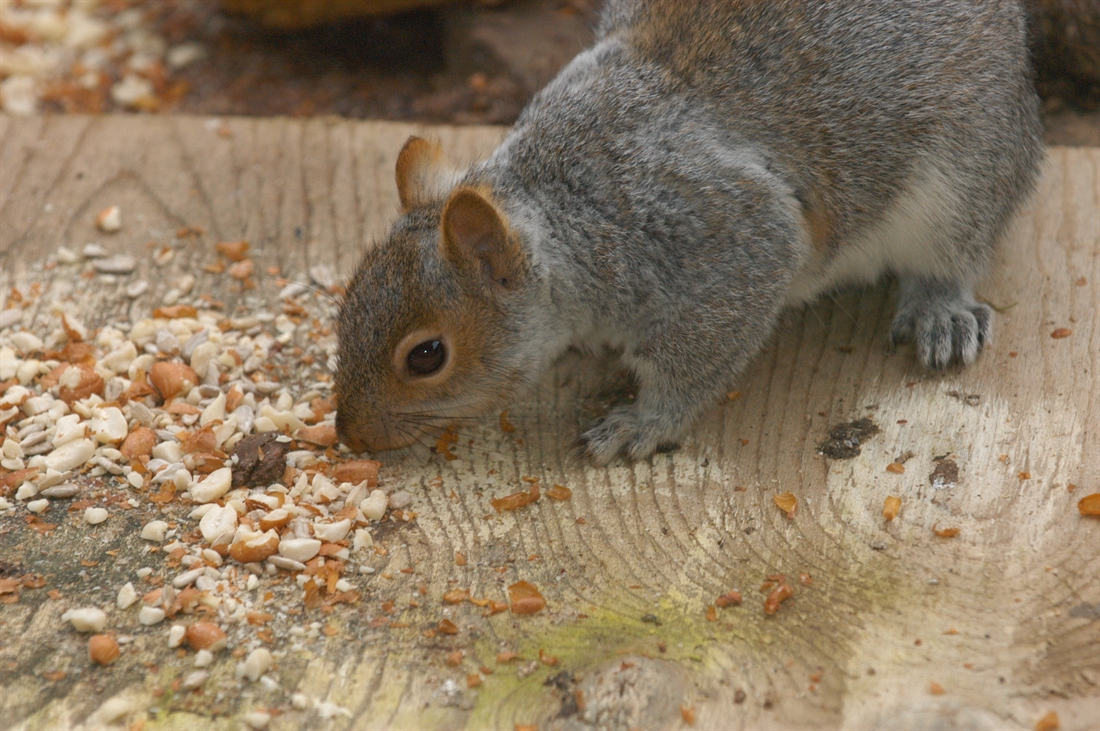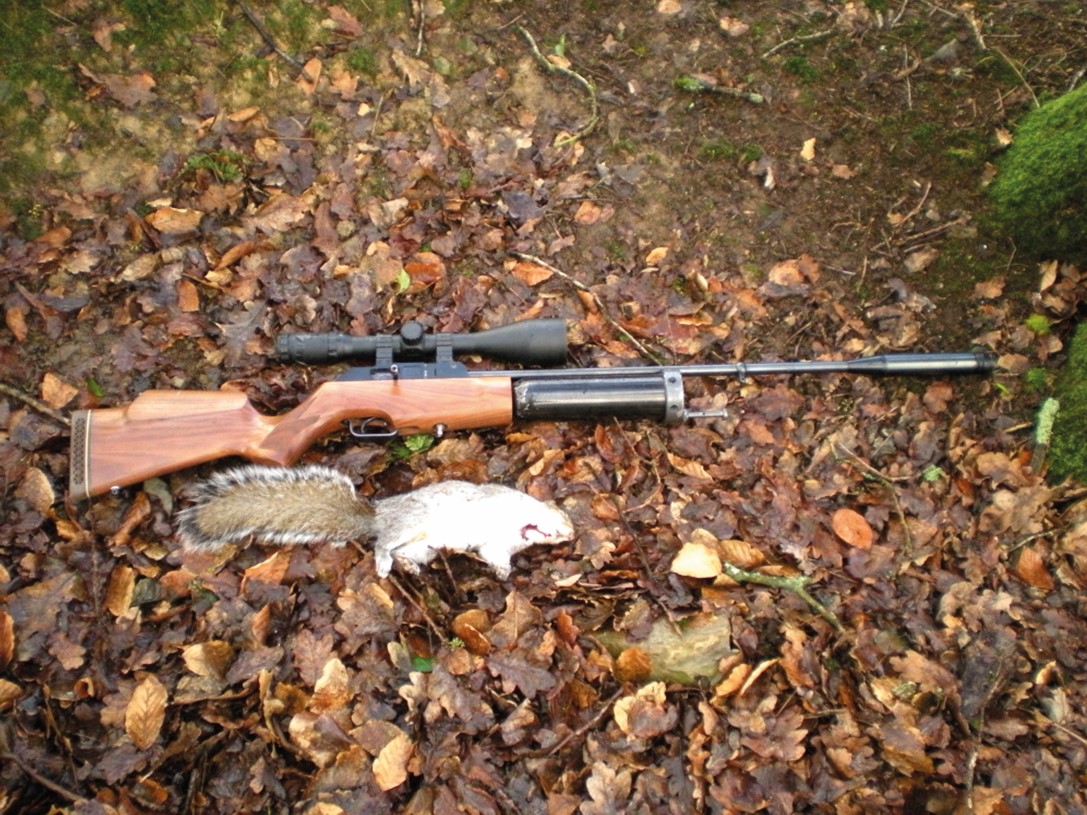Squirrelled away
Patrick Hook explains the necessity of controlling grey squirrels, considering technical, legal, ethical and safety aspects.

I began my shooting career many years ago mostly hunting squirrels. Of course there was other prey – the occasional rabbits, crows and magpies – but tree rats were the main focus through the sights of my trusty BSA Meteor Super in .22. The farmer whose ground I covered was a fanatical ornithologist, and since he hated seeing his beloved songbirds as well as his precious trees being mullered by the greys, he heartily encouraged my efforts.
As far as squirrels go, little has changed since those days. There are still just as many around and they still do as much damage. The equipment available to deal with them, however, has altered beyond all recognition. In the old days a squirrel was relatively safe once it had gained the upper branches of a tall tree. Every now and then a set of keen eyes might spot the end of a tail giving away its position, but mostly they were close to invisible. But a modern thermal spotter will generally expose even the wiliest individuals.
Worthy opponents
Squirrels can be extremely resourceful adversaries – not only are they incredibly good at hiding, but I’ve seen them swim across open water and jump seemingly impossible distances between trees. They are also very good at signalling danger to each other, either by flicking their tails or uttering a ‘vut-vut-vut’ alarm call, which is sometimes finished with a gradually diminishing shriek.
I once saw a weasel pounce on a ground- feeding squirrel. It latched its teeth into the unfortunate individual’s abdomen and tore a huge piece out, leaving its victim writhing around and screaming in agony. Within seconds the biggest squirrel I’d ever seen descended from a nearby oak and launched itself at the weasel, chasing it back and forth
in an attempt to defend its doomed brethren.
Hunting tree rats is best done with at least two people. Once a target animal has been spotted, the shooter should stay still and quiet while the other goes to the opposite side of the tree and makes some noise. The quarry in question will then almost certainly scuttle around the trunk to stay out of view, thus leaving itself open to a shot. A dog can also be used to persuade the squirrel to move. If the animal runs off and takes refuge in a drey, a very effective way of dislodging it is by poking the nest with a long pole. These are available from many gun shops and country stores, where they come in a series of short sections that screw together.
Squirrels can be shot with more or less any kind of gun – FAC conditions permitting. I was once out deer stalking with a Sauer .308 when I was compromised by a sudden series of alarm calls from high in the tree above me. The stag I was after immediately made good its escape. Somewhat annoyed, I sneaked under the branches of an adjacent holly tree and waited, out of sight. Sure enough, the squirrel’s curiosity gradually brought it down the trunk. With its tail constantly flicking, it came looking to see where I had gone. The moment it was safely below the mud bank behind, it was hit by a 148gr round at a range of about 10yd. Needless to say, it more or less dematerialised.
The first time I saw a squirrel shot with a 12-gauge, I was blown away – but not as much as the squirrel. A group of us had been trying to dislodge a particularly large example from its drey high up in a beech tree where it had taken refuge, when we were joined by an older chap toting a shotgun. He got us to simultaneously fire our air rifles into the nest, and as the occupant made a break for a safer refuge along an open branch, he blasted it with No. 6 shot.
Firing at a squirrel without a backstop in this way with any kind of powder-driven rifle is an absolute no-no. Even a subsonic .22 rimfire is out of the question. This is where air rifles come into their own, although safety must still always be taken into account. If ground-baiting is an option and you can get nice and close I would be happy with more or less anything from this stable, but if the distance was greater then my choice would be either a .17 HMR or a .22 LR.
Nature’s harvest
Sometimes nature provides its own bait, with acorns being a good example. Back in my youth the local farmer used to dump any rotten potatoes in the woods in a huge pile. The squirrels loved to eat them, so I would make myself nice and comfortable at the base of a nearby tree and simply wait for them to arrive. I learned both patience and accuracy while perfecting this art. The grain that always gets left below pheasant feeders is another draw, so if you have any of those around they can also pay dividends.
If you want to create your own bait station, all manner of foodstuffs can be used. Grain, maize, potatoes, acorns, bread, bird seed and so on will all work. The key to making
it successful, however, is time. It can take a number of days or even several weeks for squirrels to begin using a bait station regularly, but once established they’ll keep coming as long as the bait is kept topped up.
Traps and poison were once used to great effect by gamekeepers and the like, but spring traps are now regulated by such legislation as the Wildlife and Countryside Act 1981 and the Animal Welfare Act 2006. Poisons are no longer legal in the UK.
If a live-catch trap is used, then it is illegal to release any grey squirrels caught in it.
They must instead be humanely dispatched as covered by the said act, as well as the Invasive Alien Species (Enforcement and Permitting) Order 2019. Anyone doing this also needs to be aware of the tenets of the Wild Mammals (Protection) Act 1996, which rightly makes it an offence to cause unnecessary suffering to any animal.
TIPS AND INFO
The grey squirrel – Sciurus carolinensis – is a non-native invasive species introduced to the UK in the late 19th century.
Grey squirrels are immune to parvovirus and squirrelpox, which they spread to our native red squirrels. It kills them, usually within two weeks. Even when this doesn’t happen, grey squirrels will quickly displace their smaller cousins simply by out-competing them for food and habitat.
If you do decide to put bait down it’s a really good idea to set up a trail camera covering the site if you can. This will allow you to establish not only that squirrels have started visiting, but also what their favoured hours are. Typically they like the first hours after dawn.
Learning to mimic their ‘vut-vut-vut’ call can be a really good way to elicit squirrels’ curiosity and it will often encourage them to come right out into the open to see what is going on.
Safety is paramount when shooting upwards. Only air rifles and shotguns should be used, and even then always with due care. If you would like to help conserve the country’s red squirrels, there are several regions where volunteers can enlist to help cull greys. While not all schemes involve shooting, several do, so it’s worth doing an online search to find what is going on in your area.






